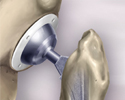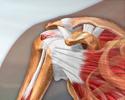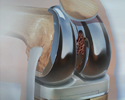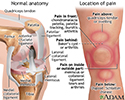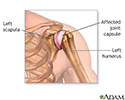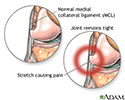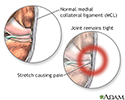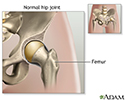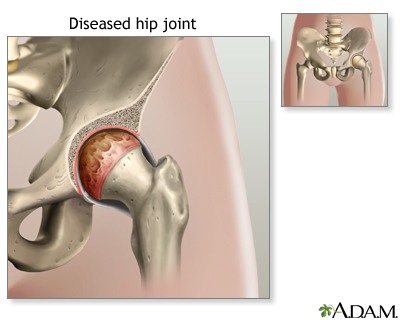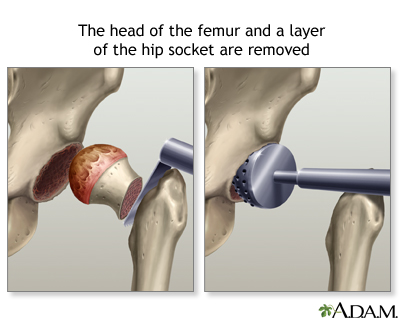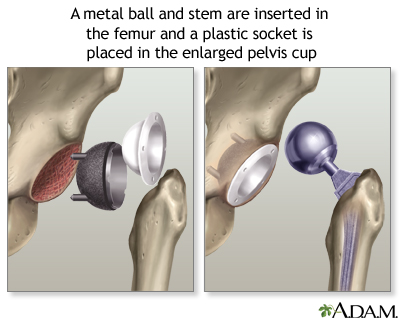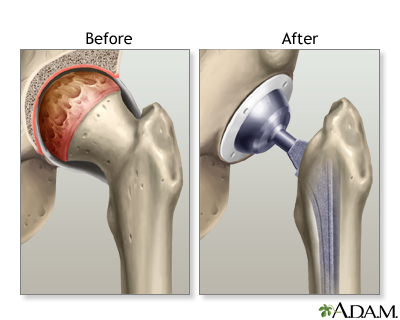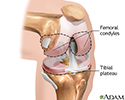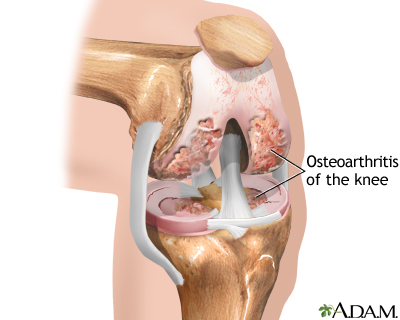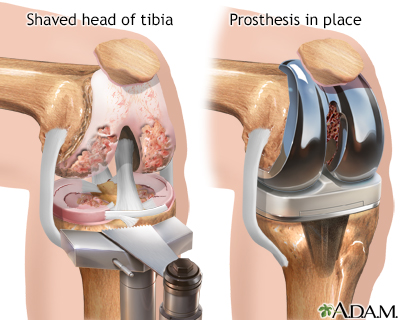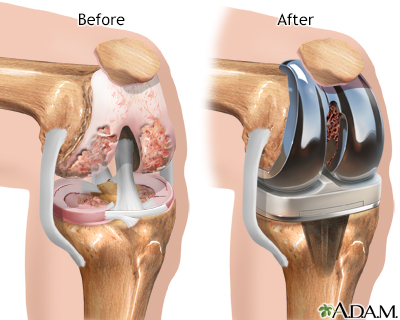Joint pain
Stiffness in a joint; Pain - joints; Arthralgia; ArthritisJoint pain can affect one or more joints.
The Basics
Tests for joint pain
Hip joint replacement - Animation
Hip joint replacement
Animation
Shoulder pain - Animation
Shoulder pain
Animation
Knee joint replacement - Animation
Knee joint replacement
Animation
Knee pain
The location of knee pain can help identify the problem. Pain on the front of the knee can be due to bursitis, arthritis, or softening of the patella cartilage as in chondromalacia patella. Pain on the sides of the knee is commonly related to injuries to the collateral ligaments, arthritis, or tears to the meniscuses. Pain in the back of the knee can be caused by arthritis or cysts, known as Baker's cysts. Baker's cysts are an accumulation of joint fluid (synovial fluid) that forms behind the knee. Overall knee pain can be due to bursitis, arthritis, tears in the ligaments, osteoarthritis of the joint, or infection.
Knee pain
illustration
Shoulder joint inflammation
An inflammation of the shoulder joint can cause pain and restricted joint movement.
Shoulder joint inflammation
illustration
Lateral collateral ligament pain
Initial treatment of an LCL injury includes ice to the area, elevation of the joint above the level of the heart, non-steroidal anti-inflammatory drugs (NSAIDs), and limited physical activity until the pain and swelling subside. A hinged knee immobilizer should be used to protect the ligament as it heals. The extent of this type of injury is usually excessive stretching of the ligament causing the pain and tenderness.
Lateral collateral ligament pain
illustration
Medial collateral ligament pain
Initial treatment of an MCL injury includes ice to the area, elevation of the joint above the level of the heart, non-steroidal anti-inflammatory drugs (NSAIDs), and limited physical activity until the pain and swelling subside. A hinged knee immobilizer should be used to protect the ligament as it heals. The extent of this type of injury is usually excessive stretching of the ligament causing the pain and tenderness.
Medial collateral ligament pain
illustration
Hip joint replacement - series
Presentation
Knee joint replacement - series
Presentation
Hip joint replacement - Animation
Hip joint replacement
Animation
Shoulder pain - Animation
Shoulder pain
Animation
Knee joint replacement - Animation
Knee joint replacement
Animation
Knee pain
The location of knee pain can help identify the problem. Pain on the front of the knee can be due to bursitis, arthritis, or softening of the patella cartilage as in chondromalacia patella. Pain on the sides of the knee is commonly related to injuries to the collateral ligaments, arthritis, or tears to the meniscuses. Pain in the back of the knee can be caused by arthritis or cysts, known as Baker's cysts. Baker's cysts are an accumulation of joint fluid (synovial fluid) that forms behind the knee. Overall knee pain can be due to bursitis, arthritis, tears in the ligaments, osteoarthritis of the joint, or infection.
Knee pain
illustration
Shoulder joint inflammation
An inflammation of the shoulder joint can cause pain and restricted joint movement.
Shoulder joint inflammation
illustration
Lateral collateral ligament pain
Initial treatment of an LCL injury includes ice to the area, elevation of the joint above the level of the heart, non-steroidal anti-inflammatory drugs (NSAIDs), and limited physical activity until the pain and swelling subside. A hinged knee immobilizer should be used to protect the ligament as it heals. The extent of this type of injury is usually excessive stretching of the ligament causing the pain and tenderness.
Lateral collateral ligament pain
illustration
Medial collateral ligament pain
Initial treatment of an MCL injury includes ice to the area, elevation of the joint above the level of the heart, non-steroidal anti-inflammatory drugs (NSAIDs), and limited physical activity until the pain and swelling subside. A hinged knee immobilizer should be used to protect the ligament as it heals. The extent of this type of injury is usually excessive stretching of the ligament causing the pain and tenderness.
Medial collateral ligament pain
illustration
Hip joint replacement - series
Presentation
Knee joint replacement - series
Presentation
Joint pain
Stiffness in a joint; Pain - joints; Arthralgia; ArthritisJoint pain can affect one or more joints.
The Basics
Tests for joint pain
Joint pain
Stiffness in a joint; Pain - joints; Arthralgia; ArthritisJoint pain can affect one or more joints.
The Basics
Tests for joint pain
Review Date: 1/16/2022
Reviewed By: Diane M. Horowitz, MD, Rheumatology and Internal Medicine, Northwell Health, Great Neck, NY. Review provided by VeriMed Healthcare Network. Also reviewed by David Zieve, MD, MHA, Medical Director, Brenda Conaway, Editorial Director, and the A.D.A.M. Editorial team.

